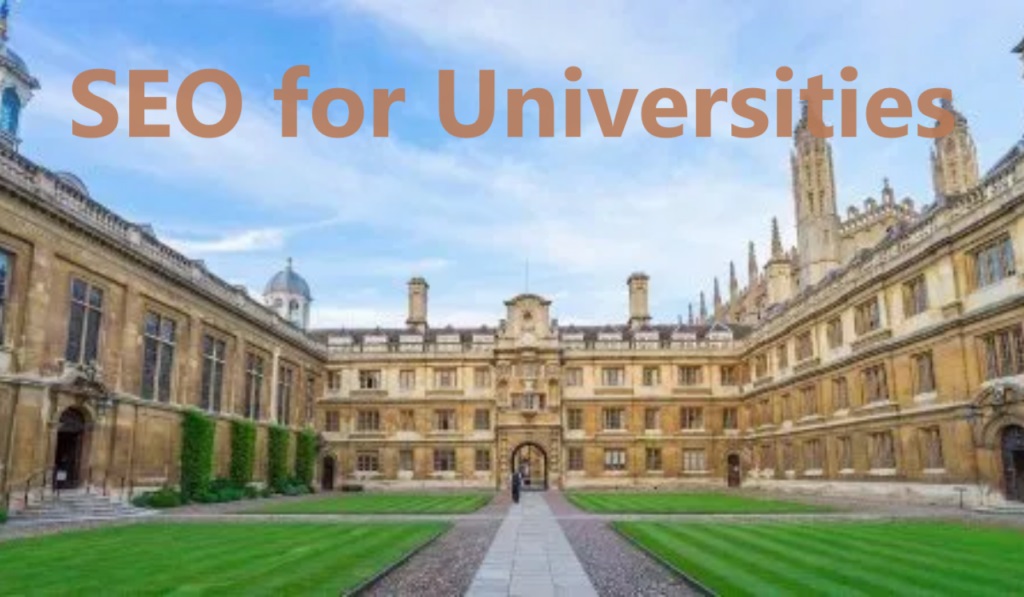In an increasingly competitive higher education landscape, university rankings have become a high-stakes game. Navigate the intricate landscape of SEO for Universities to influence rankings beyond subjective surveys and legacy factors. A few spots up or down in the U.S. News & World Report rankings can make a big difference in perceptions, enrollment rates, funding opportunities, and more, ensuring that excellent institutions are not unfairly disadvantaged by outdated metrics. This is where search engine optimization (SEO) comes into play. Done well, an SEO strategy can boost your university’s discoverability and reputation by improving visibility in search engine results. Rather than battling it out on faulty ranking metrics, schools can reshape search rankings on their terms using on-page optimization, link-building, and updated web content.
Think of it this way – when a prospective student Googles “best computer science degree” or “top southern liberal arts colleges,” you want your school to show up ahead of the pack. We’ll explore tips exactly for that below.
First though, let’s quickly cover what exactly SEO entails if you’re new to the concept…
What Does SEO for Universities Actually Involve?
SEO stands for “search engine optimization.” Essentially, this refers to strategies for improving the quantity and quality of a website’s traffic by boosting visibility in organic/unpaid search engine results.
For a university website, this typically involves actions like:
Optimizing website pages and content for relevant keyword phrases students search for when researching schools. This attracts more searches to your pages.
Earning backlinks from external websites to signal authority and relevance to search algorithms like Google. More backlinks = more trust = better rankings.
Updating page content continuously to keep pace with the competitive landscape. Evergreen, optimized content keeps search visibility strong.
Crafting compelling copy and calls-to-action across pages to increase prospective student engagement. More engagement leads to better conversions.
Streamlining site navigation and making info easy-to-find for both search bots and visitors. Improved on-site experience equates to better conversions too.
Running ongoing analysis of site metrics and rankings to identify new opportunities. SEO is an always-evolving process.
While tricky in aspects, advancing SEO doesn’t require complex technical skills for site administrators. And search visibility has proven to be one of the highest ROI channels compared to other lead generation options.
Let’s explore tips universities can leverage for specifically elevating their organic search performance and presence…
Start with an SEO Content Gap Analysis
In many ways, content is still king for sustainable SEO for universities’ success. Rather than chasing every new tactic, focusing on informational, engaging website content tailored to your target personas paves the way for long-term gains.
One smart way to identify the right content to develop is by conducting an SEO gap analysis. The goal here is to map existing site content against the phrases prospective students are actually searching for during their school research process.
Pull a list of your top-ranked web pages based on organic traffic and keyword targeting. Using Google Search Console and analytics tools, compile the topics and semantics these pages currently focus on.
Then leverage keyword research tools such as Google Keyword Planner, SEMrush, or Moz Keyword Explorer to find related long-tail phrases getting substantial search volume. For instance, semantics like:
[“benefits of a * insert major * degree”] [“jobs you can get with a theology degree”] [“what can you do with a masters in mathematics”]
Look for inspirational, question-based phrases that indicate intent to learn about specific program outcomes, career paths, and so on related to majors you offer.
By comparing existing page topics against these high-value searches, content gaps quickly become apparent. Develop fresh, dedicated pages oriented around the missing phrases where you have an opportunity to rank well.
Rinse and repeat this analysis across various personas – undergrads, grad prospects, parents, adult learners, international students and so on – customizing keyword research for their needs. Populating content gaps tailors your pages to every stage of the buyer’s journey.
Craft Compelling Program Pages
Degree program pages represent huge missed opportunities for many college websites today. Critical for both search visibility and conversion rates, yet often treated as an afterthought.
These pages deserve far more TLC and SEO attention across attributes like:
Page titles and meta descriptions: Key real estate for communicating the unique value propositions of each degree to searchers. Include program names, level specifics (Bachelors, Masters) and differentiators matching student aspirations.
Content structure: Follow an inverted pyramid approach – most important info up top. Lead with the outcomes graduates achieve, highlight career and advanced degree paths, discuss unique learning opportunities within the program, etc.
Keyword integration: Naturally work synonyms of core programs and areas of study into copy along with semantic variations students search (e.g. “jobs for English literature majors”). Avoid awkward repetition.
Alt text on images/graphics: Succinctly describe degree focuses shown in any images or charts for enhanced context.
Enhanced on-page SEO: Optimize technical elements like title tags, URL structure, internal links and schema markup too.
Distinct CTAs: Offer clear next-step options for visitors to continue their program research journey. Email signup, course catalog download, virtual tour booking, request more info, consult admissions – provide multiple options with unique tracking UTM codes.
Remember to customize templates for graduate program pages separately as well – master’s degrees, PhDs, professional programs, and so on. Requirements and outcomes differ substantially from undergrad content.
Getting these pages right has a multiplier effect, boosting organic visibility for specialized degree phrases while also increasing enrollment funnel conversions.
Target Featured Snippet Opportunities
Featured snippets represent prime real estate at the very top of Google search results – perfect for increased visibility. These short paragraph previews answer common questions searched by students with a cited page link below.
Winning one of these coveted snippets for university explainer questions can drive huge impressions and clicks. For example, if a prospect searches:
“How much does it cost to attend Arizona State University?”
Ideally you want a page on ASU’s site previewed here conveying latest yearly tuition rates along with the page URL they can visit for full cost details.
Research the questions prospective students are asking about your school experience, campus life, application requirements and so on. Identify ones aligning well to existing pages or where new snippet-bait content can be created.
Ensure pages clearly and succinctly answer the question within nice paragraph portions – this will signal to Google the page targets specific semantics with exact answers.
Sprinkling questions into surrounding content also helps, for example, on admissions pages:
So how much does it actually cost to attend our university? Well for the 2023/2024 academic year, total tuition plus room and board expenses come out to $28,900 for in-state freshmen and $47,300 for out-of-state students…
Featured snippets don’t have to be boring tuition stat dumps either. Get creative with prospects’ burning questions around student life, outcomes, application tips and why your school stands out.
The visibility boost of owning a top featured snippet can be worth hundreds of referral visits each month. Target ones aligning to priority pages with compelling answers.
Spotlight Standout Faculty Content
Showcasing thought leadership and groundbreaking research happening at your university greatly strengthens its academic brand. After all, faculty spearhead innovations advancing entire industries while mentoring future experts through teaching.
Yet, surprisingly, professor and published research content remains buried on many university sites today – despite the organic search value it offers.
Mine this opportunity by:
- Compiling profiles highlighting star faculty across degree programs. Share recent awards won, publications released, media coverage secured and more.
- Featuring case studies on influential projects professors have contributed to advancing their field.
- Creating branded areas of your site like “Leading Research” or “Faculty Insights” aggregating thought-leadership assets – published studies, incisive blog analysis on industry trends, video explainers, podcast guest appearances and so on. Consider repurposing presentation decks, lecture content or white papers with permission to enlarge this expert content pool.
- Ensuring profiles and content integrate semantic keywords and phrases related to each professor’s focus areas – both for discoverability and also elevating their personal brands.
The credibility flowing from showcasing faculty amplifies relevance for the wider university brand itself. Convert isolate pages into an interconnected hub raising awareness of pioneering work happening across schools and programs.
Stage Campus Events as Ranking Drivers
Hosting prominent events offers helpful ripple effects beyond just fostering community and engagement on campus. These activities also provide built-in opportunities for driving awareness, content and links pointing back to your university – allSignals to search algorithms you offer an intriguing destination worth discovering.
Example campus events with strong SEO potential:
- Industry conferences/summits: Position your university as a conflux point convening experts across academia and business. Live-stream keynotes and panels featuring your own faculty while sharing recap and video content after.
- Workshops/Hackathons: Showcase students actively innovating solutions around sustainability, accessibility, civic issues and more through intensive programming initiatives.
- Guest Lecture series: Draw renowned artists, authors and leaders across societal spheres to share perspectives with students in an intimate campus setting. Promote upcoming talks and provide recaps with memorable highlights.
- Cultural festivals: Celebrate and share one-of-a-kind performances, cuisine, customs and history from cultures all over the world. Photos, videos and attendees’ social shares spread wide visibility.
Tying these back to search optimization simply requires planning content and coverage with SEO in mind from the outset when conceiving events. Consider angles resonating with future students as much as attendees actually present on campus. Recognize the wider exposure value.
Convert static event webpages into content hubs with photo galleries, compiled social media reactions, recap write-ups, interview bites and so on that endure long after. Expand reach further with companion podcast episodes featuring special guests.
With creativity and initiative, universities can turn vibrant internal events into external spotlights showcasing their inspiring communities for the world to see. Bring people in on the excitement through content!
Cultivate Student Advocacy
Among the most credible voices to organically amplify what makes your university great? Current students themselves. Tapping their collective reach provides a conduit for distributing authentic branded content while also strengthening bonds.
Explore avenues like:
- Blogger/Vlogger Programs: Formalize student brand ambassador initiatives where motivated reps create written blogs, videos and social content around campus happenings, university highlights and more. Supply some loose content guidance and parameters.
- Takeover Campaigns: Coordinate students sharing a day-in-their-life Instagram or TikTok takeovers showing experiential peeks at learning, clubs, athletics, dorm culture and other (brand-safe!) aspects that resonate with their peers. These can score big engagement.
- Hashflags & Challenges: Brainstorm unifying hashtags, emojis or video challenges for students to integrate when posting university-related updates through the year on social media. Hashflags during big games or events work very well here.
- Profile Features: With permission, leverage standout student content from researchers, entrepreneurs, public speakers, artists and other exemplars by cross-posting from their profiles onto the university’s official pages. Add original headlines and context.
- Geo-Tagged Content: Encourage students to tag your university’s location/handle when sharing photos around iconic campus spots or buildings to connect imagery to your institution’s place-based profile.
Proactively involving student evangelists invests them further in the brand community while producing grassroots content reaches demographics you can’t always achieve on official channels alone. And UGC fills more knowledge gaps.
Getting sufficient participation does requires active relationship building and incentives from university marketing teams. But the collective awareness lift can outweigh the effort exponentially.
Bridge Network Gaps Between Researchers
Research ranginess represents another vital foundation block for rankings. Beyond raising faculty visibility, universities can directly enable more cross-departmental collaboration.
Often professors with aligned interests or complementary expertise aren’t even aware of each other across a sprawling campus. Yet combined their joint research could unlock groundbreaking discoveries and catalyze new programs.
Schools can bridge these gaps by:
- Hostingregular informal Poster Sessions for professors across disciplines to convene and preview studies they have underway. Inspire connections.
- Building master internal databases cataloging every faculty member’s focus areas, published works, currently funded research, memoed proposals, student group projects, associated grants or awards received, and other activity. Surface potential intersections.
- Featuring researcher video profiles allowing professors to briefly introduce their backgrounds and areas of involvement. Tag by categories and suggest related scholars they may want to meet across schools.
- Actively suggest introductions between faculty members undertaking kindred work who may not organically cross paths day-to-day. Curate working groups.
- Recognize research partners spreading collaborative spirit with new Innovation Synergy Grants and crossover apprenticeship opportunities for graduate students with multiple advisors.
In aggregate, moves strengthening ties across your wider expert network also exponentially increase the unique knowledge flowing through it. That lifts boats for everyone while underscoring leading research happening locally.
Be an SEO Resource for Professors
Extend optimization support directly to faculty to magnify search visibility for their personal sites, published studies and reputations. Offering this assistance cements your institution as an enabling partner in their individual success too.
Provide casual monthly SEO clinics allowing professors to swing by and discuss optimization needs or areas requiring troubleshooting advice.
Alternatively, develop evergreen guidelines for calls like:
Crafting Google Scholar profiles to showcase publication portfolios.
Optimizing research paper titles and abstracts for citation mileage.
Structuring semantic scholar webpage content and metadata.
Cultivating backlinks and media mentions pointing toward landmark studies.
Cleaning up duplicate web properties to consolidate authority.
Schools can compile this guidance into a Professor’s SEO Toolkit resource center available internally year-round.
Extend resources like profile photo shooting, presentation development, media training and more to position faculty as industry authorities. Rising individual tides lifts the entire university ecosystem.
The Long Game Wins in SEO
Hopefully these tips illustrate the range of possibilities within an orchestrated SEO strategy for higher ed institutions. When woven thoroughly into operations, universities can shift perceptions, elevate discovery and drive more informed engagement through unpaid search channels alone.
Ultimately over time, the compounding benefits of optimizing content, technology and community around cluster areas of strength manifest through climbing applicant rates, rising caliber of talent and growing prestige overall.
Rather than chasing short-lived rankings ploys or gimmicks, keep playing the long SEO game – evolving and distributing the unique knowledge happening at your university daily. Consistency compounds over years to shape new reputation trajectories at scale.
Students, faculty and society all deserve schools actualizing their full potential. SEO lays the digital foundation brick by brick. The rest will fill itself in.
FAQs
- How quickly can SEO impact university rankings and reputation?
Organic search is a gradual influence lever compared to paid advertising, so manage expectations accordingly. Exceptional content, thoughtful technical optimization and trusted backlink profiles compound overtime through search algorithms to indirectly shape rankings. Expect a 6-12 month runway before tangible improvements, with increasing returns in subsequent years.
- What type of resources does executing an SEO plan require from universities?
Depending on scale, often a small centralized team or individual coordinator directing strategy plus buy-in from departments, faculty and IT on properly optimizing and promoting owned content. Many monitoring and optimization tools also offer free tiers to minimize costs. Equip evangelists.
- Are there any special SEO considerations for higher education sites?
Several unique nuances, including: properly mapping extensive campus structures into site architecture, balancing dynamic profiles and deep content with strong internal linking, preserving past years’ program/archival content, showcasing faculty research, managing multiple subdomains, and regular content auditing at an institutional scale.
- What are the risks of focusing too narrowly on SEO tactics?
Obsessing over keyword volumes or competitor positioning can lead to churning thin content not actually matching audience needs. Avoid siloing – ensure optimization integrates with and enhances existing initiatives: brand-building, conversion rate optimization, community engagement, student experiences.
- How could changes to search algorithms like Google’s impact universities long-term?
Keyword targeting and backlink outputs hold less singular influence in modern Google rankings, outweighed by aggregated signals of quality content that meets genuine user needs. This shift favors institutions actively growing owned community engagement and demonstrated subject matter expertise. Stay focused here rather than isolated SEO signals.
Conclusion
Tapping SEO for universities allows colleges and universities to reshape discovery and engagement on their own terms rather than leaving impressions to third-party ranking systems alone. By optimizing web presence for visibility in organic search, schools can target relevant inbound queries, illuminate faculty thought leadership, bridge research connections and sustainably distribute the exciting happenings across campuses worldwide.
Progress requires buy-in across departments – admissions, marketing, IT, administration, alumni relations, individual academics and more. Discover the Secrets of SEO for Jewelers and apply now to unlock the compounding benefits that elevate applicant quality, student outcomes, funding rates, grad hiring performance, and general brand prestige over time. Remember, SEO success is a marathon, not a sprint – but one where institutions determine the course.


